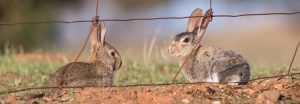
CSIRO scientists have confirmed the first pest rabbits in Victoria to die from the newly-released Korean strain of calicivirus, known as RHDV1 K5.
Two dead rabbits were found near a release site at Tanybryn, south-west of Melbourne, and another was found near a release site at Kaniva in western Victoria.
This finds come two weeks after the national release of RHDV1 K5 by community groups and land managers at 150 sites across Victoria.
Agriculture Victoria rabbit biosecurity manager John Matthews said the result confirmed that RHDV1 K5 is starting to work within the Victorian landscape.
Mr Matthews said while the release of RHDV1 K5 will boost rabbit control efforts in Australia, it was important to continue with other rabbit management techniques, such as ripping, to take full advantage of any population reductions.
The RHDV1 K5 release was conducted nationally in the first week of March 2017. It involved 599 community groups and land managers across Australia with 256 community release sites in NSW and 150 in Victoria.
There are nine nationally coordinated monitoring sites: three in NSW, four in Victoria and one each in Western Australia, South Australia, the Australian Capital Territory and Queensland.
All of the Victorian release sites received tissue sample kits as part of their mailed-out information packs sent in early February. Tissue samples from dead rabbits are now starting to be received at the laboratory testing facilities for analysis. Samples take approximately 1-2 days to be analysed by the research teams as part of the Invasive Animals CRC National RHDV Monitoring Program. The confirmed results are logged into RabbitScan and an email notification is sent back to the recipient.
“We urge those involved to continue to send tissue samples to the laboratory for testing.
“These reports are vital to our understanding of the movement of the disease around the country and will assist landholders in making future decisions about rabbit management,” Mr Matthews said.
The public is being encouraged to help track the spread of the virus by downloading the RabbitScan smartphone app. The app allows users to easily report evidence of disease to assist land managers across Australia understand the movement of the virus.
RHDV – or calcivirus – was first released in Australia in 1996 and has been actively released across Australia since then. The release of RHDV1 K5 is the first time in more than 20 years a new rabbit biocontrol was released in Australia. The RHDV1 virus was delivered through carrot or oat bait and fed to live rabbits. Infected rabbits then spread RHDV1 K5 to other rabbits by direct contact or indirectly through faeces and vectors such as insects, specifically bushflies and blowflies.
A federal Department of Agriculture spokesman said RHDV1 K5 will not result in a 90 percent reduction of pest rabbit populations, as seen with other biocontrol releases, but is expected to ‘boost’ current management and help slow down the increase in rabbit numbers.
More than 900 expressions of interest were received from groups wanting to participate in the national roll-out of the new virus.
A commercial RHDV1 K5 product will be available two months after the official planned release; however, different jurisdictions may have regulations in place on who can purchase and handle the virus and it is recommended that landholders contact their relevant state co-ordinator for more information, the department said.
Pest rabbits are Australia’s most destructive agricultural pest animal, costing $200 million in lost agricultural production every year, with a further $6 million expended on rabbit control measures.
For more information visit http://www.ava.com.au/rabbit-calicivirus or http://go.vic.gov.au/o7qyUb

This is a waste of tax payers’ money. Six million dollars to kill a handful of wild rabbits. The app only identified 700 odd sightings of wild rabbits across all Australia.